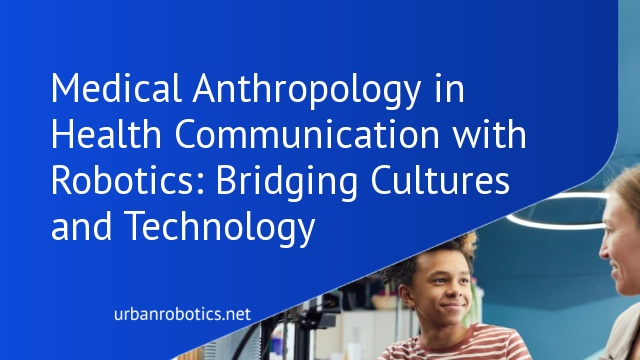Understanding Medical Anthropology
Medical anthropology examines how culture, society, and biology intersect to impact health. We analyze how cultural beliefs shape health behaviors and treatment choices. For instance, religious practices often influence patients’ healthcare decisions.
This field also explores the social determinants of health, such as socioeconomic status and environmental factors. Lower income can limit access to quality care, while environmental toxins may cause diseases in specific communities.
By understanding diverse cultural frameworks, medical anthropologists develop tailored health interventions. Adjusting communication strategies to fit cultural norms improves patient outcomes. For example, using culturally resonant narratives enhances the effectiveness of health messages.
Medical anthropology’s holistic view provides valuable insights for integrating robotics in healthcare. Recognizing cultural variations ensures technology adoption aligns with patient expectations. This fusion fosters a more empathetic, patient-centered healthcare approach.
The Role Of Health Communication
Health communication is pivotal in dispensing accurate health information and fostering patient trust. By bridging cultural gaps, it enhances the efficacy of healthcare interventions.
Importance In Healthcare
Effective health communication ensures patients understand their conditions and treatments. Clear, culturally adaptable information allows patients to make informed decisions. Medical anthropologists, for example, can guide the creation of materials that resonate with diverse patient backgrounds, ensuring inclusivity. Robotics, like AI language translators, further augment this by providing real-time, accurate translations, reducing language barriers.
Challenges In Health Communication
Despite its importance, health communication faces several challenges. Miscommunication can lead to patient confusion and non-adherence to treatments. For example, cultural misunderstandings and language barriers can distort the intended message. Additionally, the integration of robotic systems may initially create unfamiliarity and mistrust among patients. Addressing these challenges requires continuous refinement of messages with input from medical anthropologists and the adaptive capabilities of robotic technologies.
Robotics In Healthcare
Robotics is transforming healthcare by enhancing precision and efficiency. From surgeries to diagnostics, medical robots play crucial roles in various healthcare settings.
Current Applications
Robotics currently assists with surgeries, diagnostics, and patient care. Surgical robots, such as the Da Vinci system, improve precision in complex procedures. Diagnostic robots, like robotic endoscopes, offer detailed internal images. Robots also support patient rehabilitation by providing consistent, repetitive movements during physical therapy, reducing human error.
Future Potential
The future of robotics in healthcare holds immense potential. AI-powered robots could anticipate patient needs, enhancing care quality. We see robots potentially managing routine tasks, allowing healthcare professionals to focus on critical care areas. Advanced robots might conduct autonomous surgeries, offering remote surgical capabilities and expanding access to quality care in underserved regions.
Integrating Medical Anthropology And Robotics
Medical anthropology, combined with robotics, can revolutionize healthcare by tailoring interventions to diverse cultural contexts and improving patient outcomes.
Cultural Considerations
Tailoring robotic interventions to cultural beliefs and social factors enhances healthcare delivery. For example, recognizing preferences in care approaches, language nuances, and community traditions ensures respectful and effective communication. Collaborating with medical anthropologists provides insights into patient backgrounds, helping develop robots that respect cultural sensitivities and build trust. A culturally aware robotic system facilitates patient adherence to medical advice, thus improving health outcomes.
Ethical Implications
Balancing technological advancements with ethical considerations ensures responsible deployment of robotics in healthcare. Ethical concerns include patient privacy, data security, and informed consent. For instance, deploying AI-powered robots requires transparent communication about data usage and safeguarding patient information. Collaborations between engineers, healthcare providers, and ethicists help address these issues. Ethical guidelines should prioritize patient autonomy and the equitable distribution of robotic technologies to avoid exacerbating healthcare disparities.
Case Studies
Examining real-world case studies helps us understand how integrating medical anthropology and robotics in healthcare translates into improved patient outcomes. These studies highlight practical implementations, insights gained, and areas for improvement.
Successful Implementations
In Japan, robots like PARO, a therapeutic robot seal, have been used successfully in elderly care facilities. PARO integrates cultural norms that value companionship, providing emotional support and improving patient well-being. Another example is the use of culturally attuned robots in South Korea that assist with daily tasks and healthcare monitoring for the elderly, reflecting local customs and language preferences.
Lessons Learned
Evaluations from these implementations show the importance of cultural tailoring in robotic systems. We learned that involving local healthcare providers and medical anthropologists from the start ensures that the technology aligns with patient needs and cultural contexts. Another lesson is the necessity for continuous feedback loops between patients, caregivers, and developers to refine and adapt the technology, enhancing its effectiveness and patient acceptance.
Conclusion
Embracing the synergy between medical anthropology and robotics in healthcare opens doors to more empathetic and effective patient care. By integrating cultural insights into robotic systems, we can foster better communication and trust, ultimately improving health outcomes. The collaborative efforts of engineers, healthcare providers, and ethicists are vital to navigating ethical challenges and ensuring these technologies are accessible to all. As we move forward, continuous feedback and cultural adaptability will be key to refining robotic healthcare solutions, making them more responsive to the diverse needs of patients worldwide.





